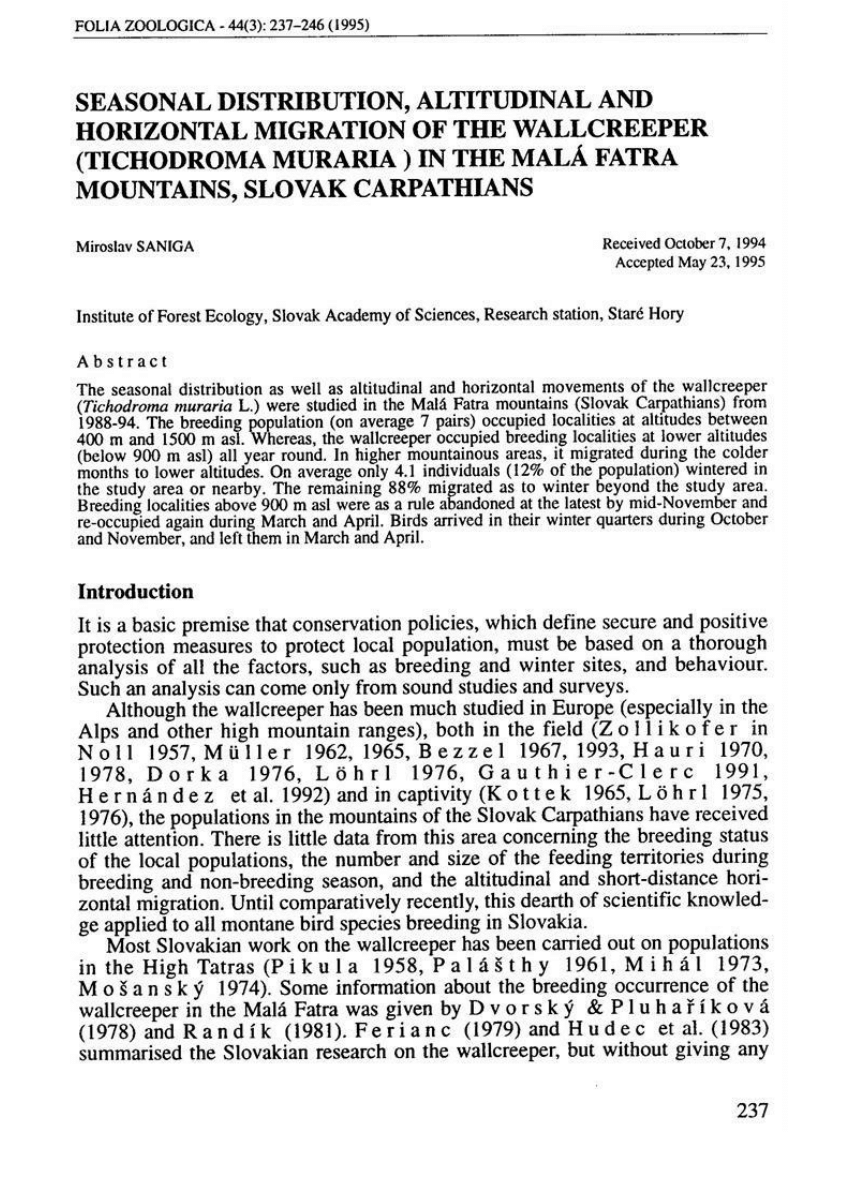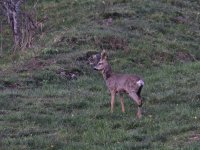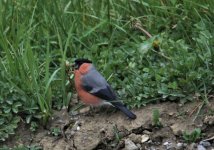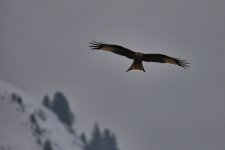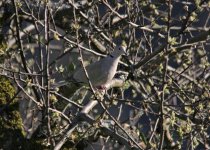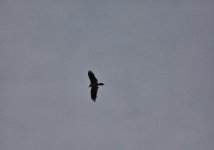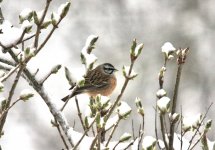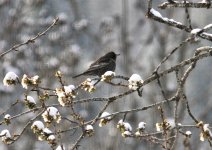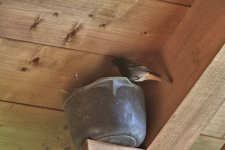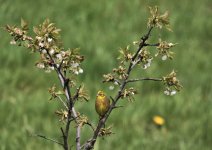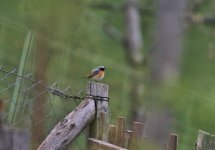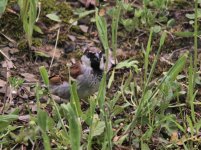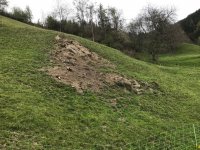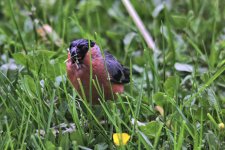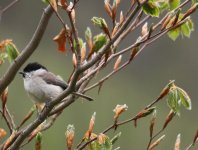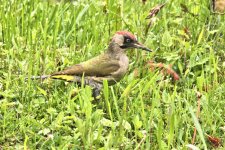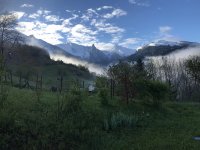April into mid May
No more Hawfinch sightings Rosbifs and the
Goshawk activity has tailed off, just two sightings this month, one distantly high in the sky surrounded by a flock of angry
Alpine Chough and another forced to leave its conifer tree hiding place by half a dozen raucous
Carrion Crow. However the
Sparrowhawk have become more visible since (the males are a prey item for Goshawk(!)), regular attacks over the past few days as the first
Greenfinch and Mistle Thrush juveniles have appeared.
A happy event here today, when we saw the
Black Redstart pair carrying food to their nest, just now I saw the male carrying away a faecal sack, who says males don’t help with the housework! They arrived back up here just before the
White Wagtail did and cleverly took over the ‘custom built’ nest receptacle that the wagtails successfully used last year, an old saucepan. The wagtail pair have decamped to the new chalet next door where they are nesting behind a beam well out of the inclement weather which has characterised almost the whole month.
Blue Tit and Great Tit pairs are using the two nest boxes positioned elsewhere on our house so I’m hoping the young don’t hatch until it warms (and dries) up a bit otherwise the adults may struggle to find them food.
The few dry days before April ended and right at the start of May brought a few more species back from their winter holidays, mostly expected but with one ‘mega’. The first
Linnet of the year had whizzed over on 18th, heading higher up to its breeding grounds (1400 to 1700m asl around these parts), a tiny green flash in the hawthorns beside our field proved to be the first returning
Firecrest on 13th, a singing
Tree Pipit on 19th has continued to display fly just 200m from home ever since and I suspect I spotted a second (hopefully the female) near it last week. A second male is also on territory less than 1km away. After thinking I’d missed their spring passage I finally heard a staging
Willow Warbler here on 24th, unusually it didn’t remain hidden as they usually do and came to check me out as I was planting onions, a couple more were about over the next two days before moving on. Wet weather on 29th had me checking through the low flying hirundines in Thônes (
Barn Swallow and Crag Martin the regulars) for perhaps a Red-rumped Swallow but the only stranger in their midst was my first
House Martin of the year. As usual I scanned the mighty Thônes rock for a sleeping Eagle Owl but came away with just another
Bonelli’s Warbler for my efforts. At home the
Yellowhammer continue to come to feed, just half a dozen most days but more magically appear if it snows (as it has a few times recently!).
A couple of cracking sightings at the beginning of May, firstly on 3rd when I went up to Les Frasses to start fence repairs with my brother in law (the snow having done a lot of damage during the winter). I had various tools but not my bins with me so Murphy’s Law came into play as we had to slow down on the track through the forest as a PAIR of
Hazel Grouse crossed sedately, flew a couple of metres, walked a bit more and then flew, giving crippling views of the grey tail as they whirred off into the forest. After explaining why they weren’t Ptarmigan(!) to my bro in law we had a very cold morning’s work but when the sun came out it prompted a couple of
Dunnock to start singing as well as a
Tree Pipit. Nutcracker, Black Woodpecker and Common Crossbill added to the experience, as did a nice beer and home-baked (by yours truly) olive, red pepper and fets loaf when we'd finished our labours! The next day was a red letter, or rather a Red - footed one – in both 2019 and 2020 I had possibles in late April and early May but brevity of views and distances left me with
falco sp only, but this time luck was on my side, the rain had finally stopped late afternoon so I did a session with my telescope and soon spotted a distant falcon doing erratic toing and froing flights over a field at the Col 2kms away. I was pretty sure what it was but against the sky I had no chance, fortunately it flew left in front of the trees, grey back, orangey yellow head and underparts, a female
Red –footed Falcon! It has become so regular in Haute - Savoie in late spring that it isn’t even a description species now but it was nevertheless a special moment.
As was 10h45 on 6th when I received my first jab

, before sticking the needle into my arm the (retired) doctor asked “Are you well?” “Apart from the pains in my knee” I quipped. “Ah”, he said “We’ve done lots of research but so far we haven’t developed an anti Covid vaccine that sorts out arthritis too, sorry”

. Driving back home I saw my first
Swift of the year, at least 50 flying low in the rain near Annecy. Since then the weather has remained dire, cold and wet in the main making ‘green’ birding, walking and gardening very unpleasant, the only bright spark was the brief visit of a handsome male
Common Redstart on 14th. Of interest (to me anyway) has been the regular visits of what looks to me like a hybrid
Italian x House Sparrow. At our last place we had a male Italian Sparrow that bred each year between 2011 and 2016 (when we moved here), producing lots of hybrid young. This male looks very similar to those, the grey area on the crown is much reduced and flecked with brown, the supercilium both in front and behind the eye and the cheeks whiter than typical House. I shall have to check the two nearest farms to see if any more oddities are amongst the hens!
Last year the first Red-backed Shrike were back up here on 17th May (around Geneva and Annecy they’ve been back for a couple of weeks now), however the dry weather in April enabled the local farmers to do a lot more ‘tidying’ in the fields so a few nesting bushes have gone to enable more grass to grow for the livestock. Being a big fan of the goats’ cheese our neighbouring farm produces I am a bit torn obviously

, though the nearest nest site to the house (about 200m away) was bushes growing around a rocky outcrop so perhaps could have been left - it’s a sad sight now (see photo).





